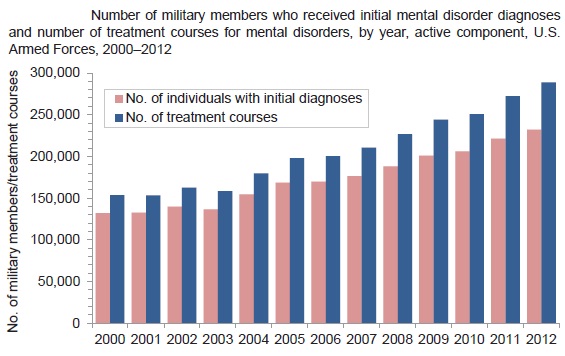By the Numbers - Jun. 9, 2014
.99%
and
3.5%
The percentages, respectively, "of all military members in treatment for mental disorders" in 2000 and 2012, representing a 60% increase, according to an article in the May 2014 issue of the Medical Surveillance Monthly Report, a publication issued by the Armed Forces Health Surveillance Center.
The report, which used "inpatient and outpatient healthcare records to estimate the numbers and proportions of U.S. military members who began treatment for mental disorders during the interval January 2000 through December 2012," indicated:
More than half of service members who received such treatment had only one treatment course, but the annual numbers of such single treatment courses increased by 60% during the 13-year surveillance period.
Other statistical findings in this report, which included findings from a variety of other studies:
- 76% more service members received initial mental disorder diagnoses in 2012 than in 2000.
- Annual numbers of treatment courses remained fairly stable from 2000 through 2003 but markedly increased in 2004, 2005, and from 2006 through 2012.
- In the past 13 years, the highest annual percentage of duty days served by active component members who were in treatment for mental disorders (3.5%) was in 2012.
- At any given time during 2012, about 1 in 29 active component Service members were in treatment for mental disorders.

May 2014 Vol. 21 No. 5 MSMR
.99%
and
3.5%
The percentages, respectively, "of all military members in treatment for mental disorders" in 2000 and 2012, representing a 60% increase, according to an article in the May 2014 issue of the Medical Surveillance Monthly Report, a publication issued by the Armed Forces Health Surveillance Center.
The report, which used "inpatient and outpatient healthcare records to estimate the numbers and proportions of U.S. military members who began treatment for mental disorders during the interval January 2000 through December 2012," indicated:
More than half of service members who received such treatment had only one treatment course, but the annual numbers of such single treatment courses increased by 60% during the 13-year surveillance period.
Other statistical findings in this report, which included findings from a variety of other studies:
- 76% more service members received initial mental disorder diagnoses in 2012 than in 2000.
- Annual numbers of treatment courses remained fairly stable from 2000 through 2003 but markedly increased in 2004, 2005, and from 2006 through 2012.
- In the past 13 years, the highest annual percentage of duty days served by active component members who were in treatment for mental disorders (3.5%) was in 2012.
- At any given time during 2012, about 1 in 29 active component Service members were in treatment for mental disorders.

May 2014 Vol. 21 No. 5 MSMR

